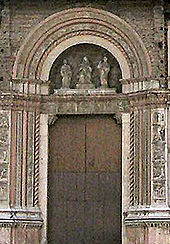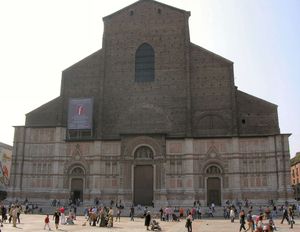- San Petronio Basilica
-
The Basilica of San Petronio is the main church of Bologna, Emilia Romagna, northern Italy. It dominates the Piazza Maggiore. It is the fifth largest church in the world, stretching for 132 meters in length and 60 meters in width, while the vault reaches 45 meters inside and 51 meters in the facade. It can contain about 28,000 persons[citation needed].
The basilica is dedicated to the patron saint of the city, Saint Petronius, who was the bishop of Bologna in the fifth century. The construction was a communal project of Bologna, not of the bishops: The property was a symbol of communal power that was not transferred from the city to the diocese until 1929; the basilica was finally consecrated in 1954. It has been the seat of the relics of Bologna's patron saint only since 2000; until then they were preserved in the Santo Stefano church of Bologna.
Contents
Architecture
 The Porta Magna with sculpture by Jacopo della Quercia
The Porta Magna with sculpture by Jacopo della Quercia
Following a council decree of 1388, the first stone of construction was laid June 7, 1390, when the town council entrusted Antonio di Vincenzo with raising a Gothic cathedral. Works lasted for several centuries: after the completion of the first version of the facade, in 1393 the first pair of side chapels were begun. The series were completed only in 1479.
However, in 1514 Arduino degli Arriguzzi proposed a revised plan in the form of a Latin cross with the intent to outdo even Saint Peter's Basilica of Rome, the greatest church of the Western Christian world even in its ancient version. By tradition Pope Pius IV halted such a majestic project.
The facing of the main facade remains unfinished: many architects (notably Baldassarre Peruzzi, Vignola, Andrea Palladio and Alberto Alberti) were commissioned to propose solutions for it, but a definitive one was never found. Jacopo della Quercia of Siena enriched the main doorway with sculptures (illustrated, left) and two new small flanking doorways, with subjects taken from the Old Testament, forming a traditional prelude to the new dispensation that is represented by the basilica itself. The heroic nudes of Adam and other figures in the rectangular bas-relief panels were an inspiration to artists of the Renaissance.
Interior
 The nave, with Vignola's ciborium
The nave, with Vignola's ciborium
The interior is notable for a Madonna with Saints by Lorenzo Costa the Younger and a Pietà by Amico Aspertini. Also the colours of the walls and the stained glass windows are noteworthy. The choir was made in 15th century by Agostino de' Marchi, while the ciborium is a work by Vignola.
Jacopo Barozzi da Vignola was chief architect of the fabbrica; his is the design of the ciborium over the altar. The vaulting and decoration of the central nave is by Girolamo Rainaldi, who completed it in 1646-1658.
Baroque music
Bologna was a principal center of Baroque music in Italy. The musical organization had been officially instituted by Pope Eugenius IV in 1436; the first regularly paid instrumentalists were added in the late sixteenth century, and in the seventeenth century San Petronio was renowned for its sacred instrumental and choral music, with its two great organs, completed in 1476 and 1596, both still in remarkably original condition; the library remains a rich archival repository. Three successive maestri di cappella marked the great age of music at San Petronio: Maurizio Cazzati (1657–71), Giovanni Paolo Colonna (1674–95) and Giacomo Antonio Perti (1696–1756).[1]
Cassini's Sundial
The church hosts also a sundial in the form of a meridian line inlaid in the paving of the left aisle in 1655; it was calculated and designed by the famous astronomer Giovanni Domenico Cassini, who was teaching astronomy at the University: at 66.8 meters it is the longest sundial in the world, following measurements that were for the time uniquely precise; Cassini and Domenico Guglielmini published an illustrated account of how the meridian was accomplished in 1695.[2]
Notable events
Middle Ages
In spite of this setback the basilica continued to enjoy the great prestige it engendered from the very beginning: Pope Clement VII chose it for the coronation of Charles V in 1530. Elisa Bonaparte, Napoleone Bonaparte's sister, is buried here.
Modern terrorist attacks
In 2002, five men were arrested who were believed to be planning to blow up the building and were connected to Al-Qaeda.[3][4] Again in 2006, plans by Muslim terrorists to destroy the Basilica were thwarted by Italian police. The terrorists claimed that a 15th-century fresco inside was insulting to Islam. The fresco, painted by Giovanni da Modena, represents a scene from Dante Alighieri's Inferno, and depicts Muhammad in Hell being devoured by demons.[5][6]
See also
- Bolognese bell ringing art, which was conceived and created in the Basilica's bell tower
- Santa Maria degli Angeli e dei Martiri, whose meridian line Pope Clement XI commissioned to rival Bologna's
Notes
- ^ Anne Schnoebelen, "Performance Practices at San Petronio in the Baroque" Acta Musicologica 41.1/2 (January 1969), pp. 37-55; see also Eugene Enrico, The Orchestra at San Petronio in the Baroque Era (Washington: Smithsonian Studies) 1976.
- ^ Recently, the book has been edited by Giordano Berti and Giovanni Paltrinieri, La Meridiana del Tempio di S. Petronio in Bologna, Arnaldo Forni Editore, S. Giovanni in Persiceto, 2000. Paltrinieri is also is the author of a booklet that summarize the work of Cassini and Guglielmini; La meridiana di San Petronio
- ^ "Italy arrests men over 'church plot'". BBC News. August 20, 2002. http://news.bbc.co.uk/1/low/world/europe/2205263.stm. Retrieved May 23, 2010.
- ^ Bruni, Frank (August 21, 2002). "Italy Arrests 5; Fresco Showing Muhammad Is Issue". The New York Times. http://www.nytimes.com/2002/08/21/world/italy-arrests-5-fresco-showing-muhammad-is-issue.html. Retrieved May 23, 2010.
- ^ News article
- ^ Philip Willan (June 24, 2002). "Al-Qaida plot to blow up Bologna church fresco". London: The Guardian. http://arts.guardian.co.uk/news/story/0,11711,742914,00.html.
Sources
- Heilbron, J.L. (2001). The sun in the church: cathedrals as solar observatories. Harvard University Press. ISBN 978-0674005365.
External links
Coordinates: 44°29′34″N 11°20′37″E / 44.49278°N 11.34361°E
Categories:- Basilica churches in Bologna
- 1390 establishments
- 14th-century architecture
- 1470s architecture
- Unfinished buildings and structures
- Gothic architecture in Emilia-Romagna
Wikimedia Foundation. 2010.


